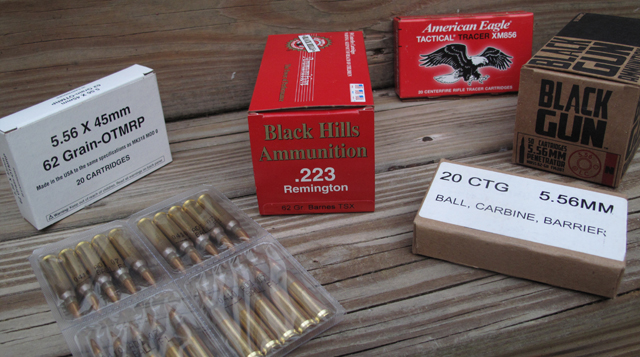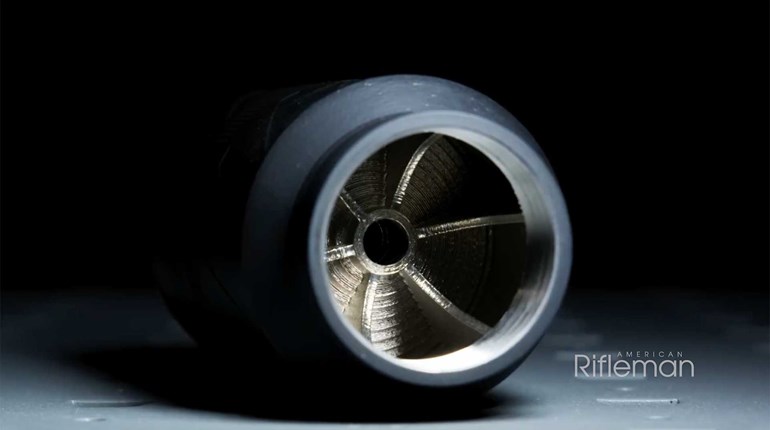

A while back, I tested every M855 "Green Tip" and equivalent SS109-type 5.56 mm load I could lay my hands on. The test methodology was simple. I shot five, five-round groups with each of eight different loads, then chronographed and further evaluated the reliability of each one. One thing was clear when the dust settled: U.S.-made Green Tip sucks in the accuracy department. When I was in the Army, I simply thought all Green Tip was the same—2- to 3-MOA ammo at best. Boy was I ever wrong. Two foreign-made loads stood out after that first comparison. Sellier & Bellot and PMC each averaged 1 MOA at 100 yards with the former managing a best-of-test .54-MOA group along the way. Our homegrown stuff was atrocious when compared to Euro loads. But that was only half the story.
I had my eye on other 62-grain fighting rounds—additional M855 loads and some improved alternatives—so I set about grabbing whatever was available for a follow-up test. Why limit myself to 62-grain loads when so many other good performing bullets are available at other weights? Because through all my testing, I have found that 62-grain, .224-caliber projectiles fly very well through all of the common 5.56 NATO twist rates: 1:7-inch, 1:8-inch and 1:9-inch. Sure I see some barrels that digest a wide range of bullet weights very well, but 62-grain bullets seem to be very twist tolerant, and they carry enough mass that I am comfortable using them for my defensive purposes. So how did it go this time? Uncle Sam did not come out on top, but the best load's accuracy was so freakishly good it would have been hard to beat even with match ammo. If you never imagined SS109 projectiles could shoot with that level of accuracy, hold on to your socks.
Of the seven rounds tested, two were actual M855 variants, four were improved munitions issued to various U.S. military elements and one was a purely commercial cartridge. All but one are available on the retail market either as factory-new or surplus ammunition. The U.S.-made military loads all had the case mouth and primer sealants you would expect to see in ammo loaded for uniformed service. One type—XM856 tracer—was repackaged in commercial boxes under the American Eagle brand.
My test methodology was the same as last time. I used my trusty 16-inch-barreled 5.56 NATO AR with a 6.5X optic and a bag rest. This carbine's 1:8-inch twist, .223 Wylde-chambered stainless steel barrel prefers Black Hills 77-grain ammo above all others, turning in sub .75-MOA groups with a 4X scope regularly. I shot this evaluation off the bench, which is not my normal MO—I am trying to learn new tricks as I get older and so far, so good. Once again, the goal was to see how different 62-grain combat 5.56 NATO loads stacked up against each other in terms of accuracy and muzzle velocity. This was not a test of terminal effectiveness, which is fairly well documented for most of the projectiles used here. I simply wanted to see how consistently each load could reach the intended targets.

The results speak for themselves. Either I happened upon a one-of-a-kind batch of Aussie F1 (M855 equivalent) or the ammo folks who brought us "g'day mate!" have figured out how to make great shooting military fodder. If the stuff I have is truly representative of ADI's F1 performance, the folks at Lake City Arsenal should be allowed to tap into the Presidential vacation budget for a watch-and-learn trip Down Under. The fact that this ammo managed to stay well below .75 MOA with a not-so-impressive velocity standard deviation of 24 fps is all the more surprising. Things that make me go hmmmm …
Black Hills Ammunition's 62-grain loads also did very well, which is good news since both of the tested loads from the company are designed specifically to deal with bad people and/or critters that need to be removed.
The MK255 Mod 1 load is the only one tested that we mortals cannot currently buy. This cartridge was designed to meet USSOCOM's need for a lead-free projectile suitable for both CQB training in shoot houses as well as for combat use. The jacketed, frangible projectile uses a copper/polymer composite core and earns its Reduced Ricochet Limited Penetration (RRLP) moniker by coming apart upon impact with hard surfaces, even at oblique angles. It is designed specifically to prevent large fragments from coming back at the shooter when used against hardened targets. However, unlike many poor-performing frangible bullets, RRLP also does very well in terms of tissue damage. The MK255 specification calls for accuracy in the sub-2-MOA neighborhood, but I have found this stuff shoots consistently tiny groups—commonly under .75 MOA—through everything I feed it into. If RRLP were available for sale, I think this would be a great choice for use as a defensive load in places where over-penetration or ricochet are concerns.
Black Hills' 62-grain TSX load is available on the commercial market and is an excellent cartridge for defensive and hunting purposes. Barnes TSX bullets are legendary and have acquitted themselves well in game as well as in battle around the world. Black Hills' 62-grain version is no slouch in the accuracy department, either. One of the really great things about TSX is it continues to expand very well at decent ranges (out to approximately 300 yards in 5.56 NATO) where other expanding projectiles turn in FMJ-like performance.
The two MK318 Mod 0 variants were developed for a USSOCOM program that sought ammunition with the capability to penetrate barriers without breaking up, while also performing well in tissue on the other side. Their averages here were respectable, coming in the same neighborhood as most of the foreign M855 loads tested in this and the previous test. They also outperformed all U.S.-made Green Tip loads in both tests.
Not surprisingly, the XM856 Tracer was on the bottom rung of this test. I don't think you can make a projectile that changes weight and balance in flight (by virtue of the tracer's burn) and expect it to be consistent. Sadly, these orange tipped fire-starters still outperformed the Winchester M855 I tested on the first go-round. Double hmmmm …
Whether you stockpile Green Tip ammo or just have a 5.56 NATO barrel that shoots 62-grain projectiles well, you will be happy to know it is steadily streaming back onto shelves. As these tests show, there are many options for accuracy and special-purpose needs. If you and your rifle are up to it, many of these loads will fly where aimed and do what they were designed to do when they get there.
Test Results
| Ammunition | Velocity | SD | Best Group | Worst Group | Average |
| ADI F1, SS109 | 2,935 | 24 | .498 | .8 | .67/.64 MOA |
| Black Hills MK255 Mod 1, 62-grain RRLP | 2,846 | 13 | .69 | .84 | .74/.7 MOA |
| Black Hills62-grain TSX | 2,967 | 11 | .66 | .94 | .77/.73 MOA |
| Lake City MK318 Mod 0 | 2,901 | 19 | .75 | 1.4 | 1.1/1 MOA |
| Federal MK318 Mod 0 | 3,000 | 23 | .7 | 2.1 | 1.3/1.2 MOA |
| Black Gun M855 | 2,981 | 24 | .935 | 2.1 | 1.6/1.5 MOA |
| American Eagle XM856 Tracer | 2,847 | 16 | 1.7 | 5.2 | 3.2/3 MOA |
Velocity and standard deviation (SD) measured in fps using an Oehler Model 35P chronograph positioned 15 feet from the muzzle for 25 rounds. Accuracy measured in inches for five consecutive, five-shot groups at 100 yards from a bag-rest-supported position.




































